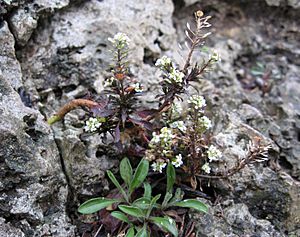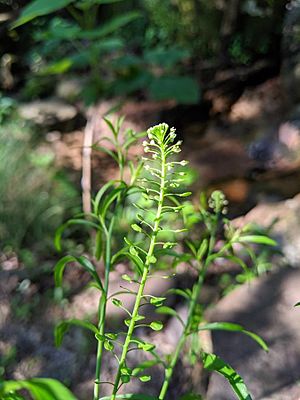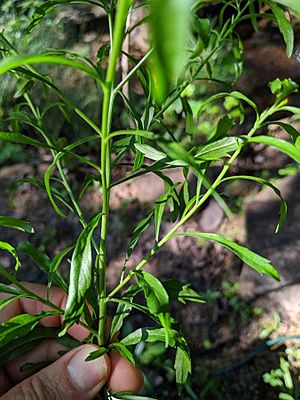Least pepperwort facts for kids
Quick facts for kids Least pepperwort |
|
|---|---|
 |
|
| subspecies virginicum | |
| Scientific classification | |
| Genus: |
Lepidium
|
| Species: |
virginicum
|
Lepidium virginicum, also known as least pepperwort or Virginia pepperweed, is a plant in the mustard family. Its scientific name is Brassicaceae. This plant naturally grows in much of North America, including most of the United States, Mexico, and southern Canada. You can also find it in most of Central America. Sometimes, it grows in other places too, because people have brought it there.
Virginia pepperweed often grows as a weed in farm fields. You can also spot it along roadsides, in gardens, and in empty areas. It likes sunny spots with dry soil.
What Does Virginia Pepperweed Look Like?
Virginia pepperweed is a plant that lives for one or two years. It is usually between 10 and 50 centimeters tall. The leaves on its stems are attached directly, without a stalk. They are long and narrow, and they get larger closer to the bottom of the plant.
One of the easiest ways to spot Virginia pepperweed is by its special flower clusters. These clusters are called racemes. The plant's stem has many branches, making the racemes look like a bottlebrush. First, small white flowers appear on these racemes. Later, they turn into small green fruits.
All parts of the Virginia pepperweed plant have a peppery taste.
How Can Virginia Pepperweed Be Used?
This plant is safe to eat! The young leaves can be cooked like spinach. You can also eat them raw, for example, in salads. The young seedpods can be used as a replacement for black pepper. The leaves are healthy too, as they contain protein, vitamin A, and vitamin C.
See Also
 In Spanish: Perejil de la tierra para niños
In Spanish: Perejil de la tierra para niños



